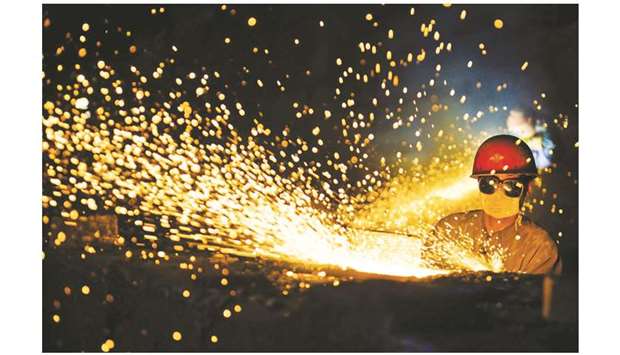China’s producer prices fell the most in more than three years in October, as the manufacturing sector weakened on declining demand and a knock from the Sino-US tariff war, reinforcing the case for Beijing to keep the stimulus coming.
The producer price index (PPI), seen as a key indicator of corporate profitability, fell 1.6% in October from a year earlier, marking the steepest decline since July 2016, National Bureau of Statistics (NBS) data showed yesterday.
Analysts had tipped a contraction of 1.5% for the PPI.
In contrast, China’s consumer prices rose at their fastest pace in almost eight years, driven mostly by a surge in pork prices.
Some analysts say the CPI rise could become a concern for policymakers looking to introduce measures to prop up demand.
However, core inflation — which excludes food and energy prices — pressures remain modest.
The factory deflation was punctuated by falling raw material prices, including in the oil and gas extraction and ferrous metal smelting industries.
It aligns with other indicators showing shrinking manufacturing activity in October, with the official Purchasing Managers’ Index (PMI) indicating contraction for a sixth straight month.
Zhao Wei, a macro analyst with Wuhan-based Changjiang Securities, said the drag from the real estate sector, which is suffering from a government crackdown on sales speculation and policy tightening on financing for developers, will also become more pronounced.
“Looking ahead, while a low base from last year will provide some support in the next few months, PPI deflation is likely to continue as overall demand is still under pressure,” said Zhao. “The PPI may continue to be within a negative growth range.”
While Washington and Beijing work on finalising the first part of a phased trade agreement, many analysts are wary of the potential back and forth after the sudden collapse of earlier talks in May.
Chinese manufacturers, meanwhile, are expected to face continued pressure from existing tariffs.
More US tariffs against China are set to take effect on December 15, although officials from both China and the US said this week they have agreed to roll back tariffs on each others’ goods if a “phase one” trade deal is completed.
On Friday, though, President Donald Trump said he has not agreed to the rollbacks sought by China.
The more than year-long trade war has cost China $35bn as the US has cut down on Chinese imports, driving up prices for American consumers, according to a UN study published on Tuesday.
To drive down funding costs and boost the economy, China for the first time since 2016 cut the interest rate in its one-year medium lending facility (MLF) loans.
The Chinese authorities, though, have been relatively restrained in providing stimulus measures and the cut was by only 5 basis points.
But surging consumer inflation is adding to the headaches of policymakers who are racing the calendar to meet Beijing’s annual growth target as the world’s second largest economy slows to the lower end of a 6%-6.5% range for 2019.
October’s consumer price index (CPI) rose 3.8% year-on-year, the most since January 2012 and beating analysts’ expectations for 3.3% rate.
The rise was driven largely by a steep climb in pork prices and other meats.
Core CPI for October remained benign at 1.5%. For the full year of 2019, China is aiming for a CPI target of around 3%. It rose 2.6% in the January-October period.

A worker wearing protective glasses welds steel products at a heavy equipment manufacturing factory in Luoyang, Henan province (file). China’s manufacturing sector weakened in October on declining demand and a knock from the Sino-US tariff war, reinforcing the case for Beijing to keep the stimulus coming.


